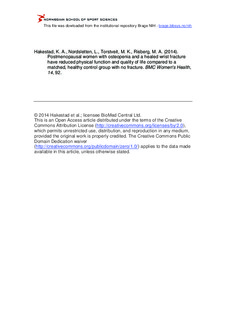| dc.contributor.author | Hakestad, Kari Anne | |
| dc.contributor.author | Nordsletten, Lars | |
| dc.contributor.author | Torstveit, Monica Klungland | |
| dc.contributor.author | Risberg, May Arna | |
| dc.date.accessioned | 2015-04-17T08:53:32Z | |
| dc.date.available | 2015-04-17T08:53:32Z | |
| dc.date.issued | 2014-08-03 | |
| dc.identifier.citation | BMC Women's Health. 2014, 14, 92 | nb_NO |
| dc.identifier.uri | http://hdl.handle.net/11250/281954 | |
| dc.description | © 2014 Hakestad et al.; licensee BioMed Central Ltd. | nb_NO |
| dc.description.abstract | Background: Fractures lead to reduced physical function and quality of life (QOL), but little is known about postmenopausal women with osteopenia and a healed wrist fracture. The purpose was to evaluate physical function in terms of quadriceps strength, dynamic balance, physical capacity and QOL in postmenopausal women with osteopenia and a healed wrist fracture compared to a matched, healthy control group with no previous fracture.
Methods: Eighteen postmenopausal women with osteopenia (patients) (mean age 59.1 years, range 54 – 65) and a healed wrist fracture were matched to 18 healthy control subjects on age (mean age 58.5 years, range 51 – 65), height, weight and body mass index (BMI). We measured quadriceps strength at 60°/sec and at 180°/sec with Biodex 6000, dynamic balance with the Four Square Step Test (FSST), physical capacity with the six-minute walk test (6MWT) followed by the Borg’s scale (BS), and QOL with the Short Form 36 (SF-36), bone mineral density (BMD) with dual x-ray absorptiometry (DXA) and physical activity level with the Physical Activity Scale for the Elderly.
Results: The patients had 17.6% lower quadriceps strength at 60°/sec (p = 0.025) at left limb and 18.5% at 180°/sec (p = 0.016) at right limb, and 21% lower at 180°/sec (p = 0.010) at left limb compared to the controls. Impaired performance for the patients was found with 2.4 seconds (p = 0.002) on the FSST, 74 metres (p < 0.001) on the 6MWT, and 1.4 points (p = 0.003) on the BS compared to the controls. The patients scored lower on the sub-scales on the SF-36 role limitations-physical (p = 0.014), bodily pain (p = 0.025) and vitality (p = 0.015) compared to the controls.
Conclusions: The patients with osteopenia and a healed wrist fracture scored significantly lower on quadriceps strength, dynamic balance, physical capacity and QOL compared to the matched controls. Greater focus should be put on this patient group in terms of rehabilitation and early prevention of subsequent fractures. | nb_NO |
| dc.language.iso | eng | nb_NO |
| dc.publisher | BioMed Central | nb_NO |
| dc.subject | osteopenia | nb_NO |
| dc.subject | quadriceps strength | nb_NO |
| dc.subject | dynamic balance | nb_NO |
| dc.subject | postmenopausal women | nb_NO |
| dc.subject | wrist fracture | nb_NO |
| dc.title | Postmenopausal women with osteopenia and a healed wrist fracture have reduced physical function and quality of life compared to a matched, healthy control group with no fracture | nb_NO |
| dc.type | Journal article | nb_NO |
| dc.type | Peer reviewed | nb_NO |
| dc.subject.nsi | VDP::Medical disciplines: 700::Basic medical, dental and veterinary science disciplines: 710 | nb_NO |
| dc.subject.nsi | VDP::Medical disciplines: 700::Clinical medical disciplines: 750 | nb_NO |
| dc.subject.nsi | VDP::Medical disciplines: 700::Health sciences: 800 | nb_NO |
| dc.source.journal | BMC Women's Health | nb_NO |
| dc.description.localcode | Seksjon for idretssmedisinske fag / Department of Sports Medicine | nb_NO |
